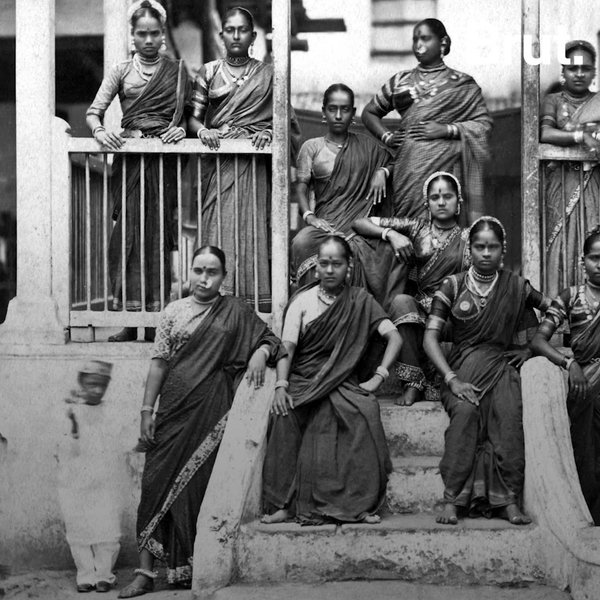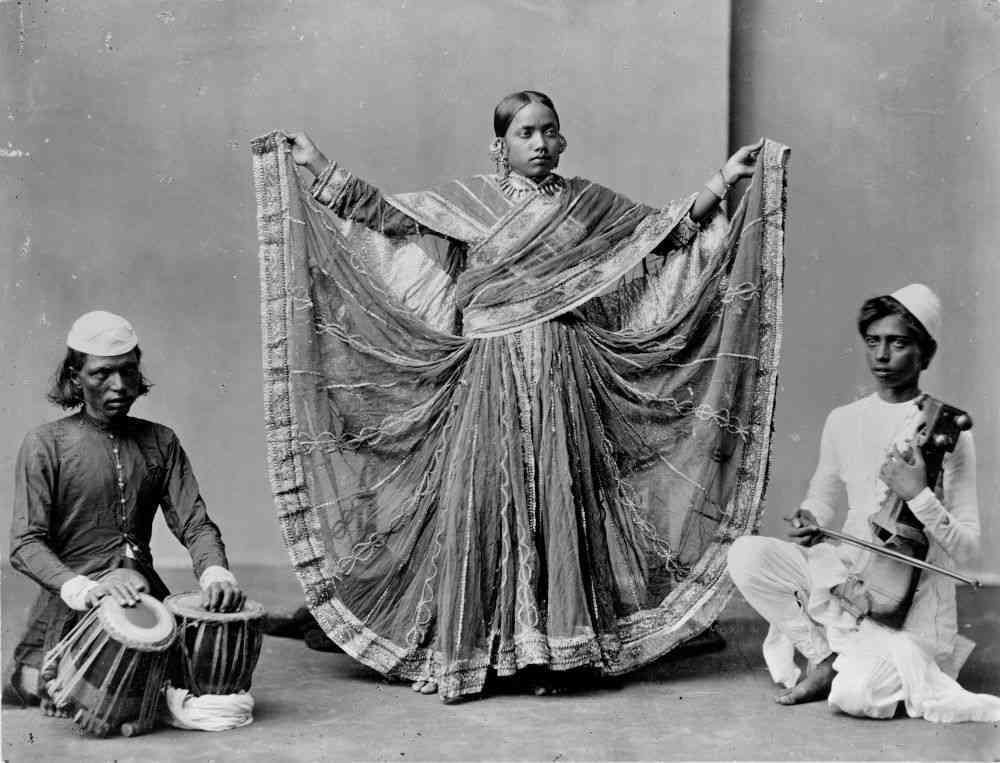Editor’s Note: FII’s #MoodOfTheMonth for March, 2022 is Women’s History Month. We invite submissions on the contributions of women, the trajectory of the feminist movement and the need to look at history with a gender lens, throughout the month. If you’d like to contribute, kindly email your articles to sukanya@feminisminindia.com
Prostitution is touted as the world’s oldest profession. Yet, as far as the history of the Indian subcontinent and that of many Asian countries are concerned, prostitution is a modern term. It is modern in two ways: one, that it is the materiality of the modern world, particularly the capitalistic world, that allows it to flourish and function the way it does today. Secondly, what today constitutes a ‘business of providing pleasure’ was once upon a time, a cultural transaction in which sex was incidental, rather than a solely business exchange.
The use of the word prostitution to characterise the world of 18th-19th century Tawaifs, or others involved in the business of pleasure, blurs the multiplicity of their identities and reduces them to the singular common bond — pleasure providers.
Prostituion: The genesis of the trade
While scholars trace the genesis of ‘prostitution’ to ancient Greece hetaerism or the courtesans of Buddhist India and the later era of concubinage, Sumanta Banerjee notes that there are marked differences. For one, the moral judgement associated with contemporary prostitutes was not a trade-mark of Hetaerism, nor were the concubines akin to modern prostitutes for they did not have the freedom to sell themselves in open market and ultimately, were feudal captives.
The modern prostitute who functions in the web of capitalism, experiences intensification of division of labour and specialisation of skills, thus reducing them to the niche function of providing sexual pleasure. The prostitue in turn, becomes a “body”. This is an important distinction since the Tawaif was imbued within a cultural economy and was an emotionally depthful character. The advent of colonialism led to a split between their emotive being and their physical being.

The first generation of prostitutes
Historian and cultural theorist Sumanta Banerjee, who has worked on the history of rural Bengali women notes that two major dislocations occurred: the depredations of the Marhatta raiders which unleashed anarchy and rape in the countryside, leading to abandoning of many rural women, coupled with a second dislocation in the wake of the 1770 famine that saw starving families selling their daughters, widows being displaced and dancers and singers losing patronage.
Banerjee notes, “It was these rootless and displaced women —who formed the first generation of prostitutes in the colonial world of market economy in 19th century Bengal.” These women’s first settlements emerged in mofussil towns that were centers of trade and commerce. Besides the traders, subordinate Bengali officers of the Bhadralok, settled in these towns without their families and consequently, there was an intensification of the utilitarian value placed upon sex and the body of the “prostitute”.
The courtesan was uniquely placed as Urvashi Dalal shows, to leverage the new power space for they combined the cultural refinement of the artist woman with the sexual currency of the fahisha; only more limited and exclusive. In fact, court documents point to the fact that even post their displacement, “the Tawaifs were not only recognised as preservers and performers of the high culture of the court, but they actively shaped the developments in Hindustani music and Kathak dance styles”
Besides the reasons listed above, many women from oppressed social locations came to Calcutta as maid-servants and had to work as prostitutes in the evening to supplement their earnings. Clearly then, what we understand by the modern-day sex-worker, were in the 18th and 19th century, a multi-faceted community who were engaging in sex-work either incidentally or consciously, and “sex-work” was not a singular, homogenised form of engagement.

Prostituion and the world of Tawaifs
Sure, Tawaifs and the others involved in the business lived a rather precarious life. Yet, their lives were not “debased”, economically scant or marked by limited exercise of agency. But with all the wealth, love was still elusive. Umrao in a conversation with Mirza, remarked about her peer, “However, fortune did not favour her. But why blame fortune? She was her own worst enemy. She was not really suited to this profession. She had looks sent from heaven, but the curse of her beauty was that she wanted to be loved and return the love she received.”
Dance, music, art and aesthetics were central to the life of the courtesan. In fact, their mastery of these skills were a prerequisite for them to enter the trade. The authority of their skills was so profound that young sons of noble men would engage in the company of Tawaifs to acquire the social etiquettes of the Awadhi Culture of nafasat (decency), nazakat (delicacy) and sharafat (the ashraf culture).
As Umrao Jan, also recalls, “In Khanum’s house, the girls learnt not only how to dance and sing but also how to read and write. For this purpose, she had set up a school and there, she employed a maulvi.”
Also read: Mirza Hadi Ruswa’s ‘Umrao Jan Ada’: A Novel That Maps The Forgotten History Of The Courtesan Culture
Tawaifs: Changing terrains and the nouveau power bearers
The Tawaifs were not ornate courtesans at the mercy of male patrons. In fact, they successfully exercised agency in their participation in realpolitik. Ruth Vanita, in her reading of Rekhti opines that while many scholars see polygamy as oppressive to women, it ignores the case of Awadh where unlike other states, the Nawab married courtesans too and thereby allowed non-aristocratic women and by extension their families an avenue for social mobility.
As, “sugrihani” became the norm ,parallel to the Victorian housewife, with the advent of colonialism, new moral codes emerged and they were legitimated by couching them in a medico-legal parlance. Leveraging the imagery of venereal disease, all ‘itinerant and deviant’ people were transformed into prostitutes. Consequently, all female entertainers and people outside heterosexual marriages were deemed ‘deviant’
The courtesan was uniquely placed as Urvashi Dalal shows, to leverage the new power space for they combined the cultural refinement of the artist woman with the sexual currency of the fahisha; only more limited and exclusive. In fact, court documents point to the fact that even post their displacement, “the Tawaifs were not only recognised as preservers and performers of the high culture of the court, but they actively shaped the developments in Hindustani music and Kathak dance styles.”
One of the stereotypes that Umrao Jan of Mirza Ruswa weaves is that it obliterates the agentic behavior of the Tawaifs in choosing the profession, by portraying Umrao’s induction in the trade as emanating from kidnapping. This is far from the truth as Oldenburg’s interview with courtesans showed that these women had willingly joined the kotha, due to exploitation and oppression of varying levels in their natal or conjugal homes, a common parlance to underline this was the idea of “qismat badalna”, a change of destiny.

The unmaking of the Tawaif and the making of the ‘randi’
“And how far can you trust these filthy whores? They’re usually full of disease. You shouldn’t even let their shadow pass over you” (Umrao Jaan). Towards the end of 19th century and the beginning of 20th century, the Tawaifs were stripped completely off their multi-dimensionality and turned into a prostitute, the ‘randi‘. Ironically, the word randi, originating from rand, referred to widowed women.
As, “sugrihani” became the norm ,parallel to the Victorian housewife, with the advent of colonialism, new moral codes emerged and they were legitimated by couching them in a medico-legal parlance. Leveraging the imagery of venereal disease, all ‘itinerant and deviant’ people were transformed into prostitutes. Consequently, all female entertainers and people outside heterosexual marriages were deemed ‘deviant’.
At the intersection of new moral codes, regulation of sexuality and racism, a myth of the “prostitute caste” was woven that engulfed all concubines, devdasis, nautch girls, and courtesans, into one category and thus, portrayed them as historically debased. Courtesans were one of the first victims of this myth-making.
The death of the Tawaif was not merely the loss of a cultural form. It was the violent seizing of agency and respect from those who erstwhile had what the intensficiation patriarchy despised, sexual and economic freedom, and a place in the respectable world.
Also read: Ground Report: The Worsened Health & Financial Conditions Of Sex Workers
Author’s note: The use of word “prostitution” here is to underline the context in which the word came to be originally used and the eventual transitions that took place to the usage of the word sex worker. The two have not been used interchangeably, but parallely, to echo scholarly and social shifts.
Featured Image: Dawn
About the author(s)
Harshita is a public policy consultant working at the intersection of gender, climate change, and disability. An alumna of Jesus and Mary College, University of Delhi, and the Institute of Development Studies, University of Sussex, her work draws on her training in History and Development Studies to unpack gender as a social and structural construct.




